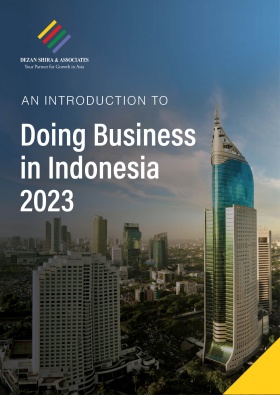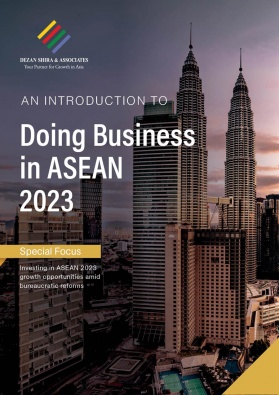Investing in Indonesia: The 2023 Mid-Year Investment Report
We discuss standout sectors in this H1 2023 Indonesia investment report, shedding light on key areas ripe for foreign capital infusion, trade expansion, and business development.
Indonesia recorded some US$44 billion in combined domestic and foreign investments for the first half of 2023 (January – June), according to data from the Investment Coordinating Board, or the BKPM. The country is on track to surpass its combined total domestic and foreign investment target of 1,400 trillion rupiah (US$92 billion).
During the first half of 2023, Indonesia recorded 363 trillion rupiah (US$23 billion) in foreign investment and 315 trillion rupiah (US$20.4 billion) in domestic investments.
Indonesia recorded an estimated US$43 billion in foreign investment in 2022, an increase of 44 percent from 2021 and the highest in the country’s history. When combined with domestic investments, this totals to US$80 billion, an increase of 34 percent from 2021.
Notable sectors that attracted major foreign investment in first half 2023
Basic metal mining
The basic metal mining sector continues to dominate the foreign investment landscape in Indonesia.
The sector recorded 89 trillion rupiah (US$5.7 billion) in foreign and domestic investments for the first half of 2023.
The sector has been boosted by global demand for nickel ores, ferronickel, and nickel pig iron, in addition to the development of the downstream metal industry. Indonesia has fully banned the export of raw nickel ores since 2020 followed by other raw commodities such as bauxite.
Home to the largest nickel reserves of approximately 22 million tons, Indonesia’s government has been focused on leveraging these reserves to attract investments to develop local smelters. As such, the export value of processed nickel contributed significantly to government revenues in 2022, reaching US$30 billion; a huge increase from just US$1 billion in 2015.
Further, nickel is an important component for electric vehicle (EV) batteries, an industry in which Indonesia is aiming to become an EV manufacturing hub—the country is targeting to become one of the top three global producers for EV batteries by 2027.
Transportation, and telecommunications
According to the BKPM, Indonesia’s transportation and telecommunication sectors received some 79 trillion rupiah (US$5.1 billion) in foreign and domestic investments in the first half of 2023. An estimated US$3.1 billion of this total came from foreign investments.
Unequal economic development in Indonesia has resulted in many regions outside of the island of Java requiring the optimizing and modernizing of infrastructure and public transport. As such, the Indonesian government is encouraging investments in transport infrastructure through alternative funding mechanisms such as Public Private Partnerships.
Indonesia’s telecommunications sector is one of the fastest growing in Asia, driven by new mobile technology, and changing consumer behavior. With a market size that is expected to grow to over US$14 billion in 2028 from US$13 billion in 2023, the industry is currently supported by 212 million internet users and 338 million mobile connections (the third largest in the world). The information and communication sector has thus a bright outlook with Indonesia’s potential to be the region’s most promising ICT sector yet to be unleashed.
Mining
Foreign and domestic investments in Indonesia’s mining sector reached 71 trillion rupiah (US$4.6 billion) in the first half of 2023. From this total, an estimated US$2.1 billion came from foreign investments.
In addition to mineral ores, the country is home to an abundance of coal and gold of which the majority is exported.
Indonesia is the world’s third-largest exporter of coal and the world’s largest exporter of thermal coal. Around 687 million tons of sedimentary rock were produced in 2022, from which 494 million tons were exported. For 2023, the government is targeting coal exports to reach record 518 million tons out of a total production of 695 million tons. In terms of gold production, Indonesia produced 70 metric tons in 2022, ranking it ninth globally. At its height, the country produced 139 metric tons of gold in 2019. Further, Indonesia’s estimated 3.5 billion tons in gold reserves make it the fifth largest reserve in the world after Australia, Russia, South Africa, and the United States.
Residential, industrial zones, and office space
Housing, industrial zones, and office space recorded 58 trillion rupiah (US$3.7 billion) for the first half of 2023.
Indonesia’s government has made the development of the country’s industrial and special economic zones (SEZ) a priority policy with the aim of attracting over US$50 billion in foreign investment over the next decade, particularly for SEZ-oriented manufacturing.
Investors operating in these zones will find they are supported by well-integrated infrastructure from highways, drainage systems, high-speed internet and communication systems, ports, and airports. Moreover, the Indonesian government has prepared an array of fiscal and non-fiscal incentives in its special economic zones, such as an easier immigration process, corporate income tax reductions, and exemptions on import duties and excise duties, among many others.
Commercial real estate firm Colliers Indonesia noted that occupancy rates for office space in Jakarta’s central business district Indonesia’s current capital, Jakarta, was at 73.7 percent as businesses saw the return of employees to their offices. It is expected that most developers will be focused on maximizing existing properties in the short term. Jakarta is predicted to see an estimated 700,000sqm of new office supply by 2025.
Chemicals and pharmaceuticals
Chemicals and pharmaceuticals recorded 48 trillion (US$3.1 billion) in combined foreign and domestic investments so far this year.
Indonesia is the largest pharmaceutical market in Southeast Asia and is expected to expand to over US$11 billion in 2025 from US$7.6 billion in 2020. However, the industry is still highly dependent on the import of raw materials—some 90 percent of the pharmaceutical raw material supply. Generic drugs are the largest segment of the country’s pharmaceutical market.
Demand for pharmaceutical products and healthcare, in general, is increasing in Indonesia mainly due to a rapidly growing consumer class and better access to healthcare facilities. The country has the world’s largest free healthcare program with some 246 million participants. Those registered with the BPJS program are eligible to receive free health services ranging from simple dental check-ups to serious procedures, such as organ transplants.
Conclusion
In summary, Indonesia’s diverse investment opportunities across these sectors demonstrate the country’s commitment to economic growth and development. With a clear focus on infrastructure, resources, and emerging industries, Indonesia is positioning itself as an attractive destination for both domestic and foreign investors, setting the stage for continued economic expansion in the years ahead.
About Us
ASEAN Briefing is produced by Dezan Shira & Associates. The firm assists foreign investors throughout Asia and maintains offices throughout ASEAN, including in Singapore, Hanoi, Ho Chi Minh City, and Da Nang in Vietnam, in addition to Jakarta, in Indonesia. We also have partner firms in Malaysia, the Philippines, and Thailand as well as our practices in China and India. Please contact us at asean@dezshira.com or visit our website at www.dezshira.com.
- Previous Article Exploring Friendshoring: Shifting Operations in Asia and China+1
- Next Article Southeast Asia’s Tech Boom: A Gateway for Baltic Investors







